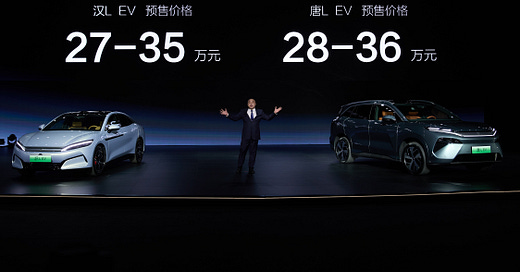A caveat to BYD's new five-minute fast-charging EV platform
That's almost as fast as refueling a normal car, but let's do some calculations first.
Chinese EV maker BYD has unveiled a new “Super e-Platform” with a peak charging speed of 1MW (1,000kW), which is apparently the fastest for mass-production cars. In a demo with BYD’s new Han L sedan (rear-wheel-drive variant), its silicon carbide battery went from 5% to a little over 63% in a mere five minutes, which equates to a gain of 407km. That’s almost as practical as refueling a normal car — on paper, at least.
Many reports skipped the fact that the quoted figure is based on the more generous CLTC standard. Flipping that to WLTP using a 0.82 conversion factor, we get a more realistic 334km. In other words, based on WLTP, BYD’s fast-charging demo still showed a speedy 81.4km-per-minute performance, not to mention how this much juice should be plenty for many more city trips.
For comparison’s sake, my own Smart #1 Brabus — manufactured by Geely — has a range of 400km (WLTP), and with 150kW “fast” charging, its battery can go from 10% to 80% — let’s call this 40km to 320km, i.e. a 280km gain — in under 30 minutes. That’s around 9.3km per minute. (Unfortunately, there’s no official figure on reaching a full charge.)
Of course, given the changes throughout a charging cycle, it’s not fair to compare these two speed figures directly, but it’s still an indication on the innovation leap since the #1 Brabus’ launch in August 2022.
While BYD’s “Super e-Platform” impresses with charging speed and motor power (30,511rpm), I was hoping to get an update on its promised 1,000km (820km WLTP) range breakthrough — something that battery giant CATL is already offering via its clients, namely Nio and Geely’s Zeekr.
The Han L sedan has a total range of 701km CLTC / 575km WLTP for its rear-wheel-drive version, and 601km CLTC / 493km WLTP for the all-wheel-drive variant. While the official top speed is 270km/h under fixed conditions, BYD claims this EV can actually reach up to 305km/h. Internally, it's equipped with luxurious features like massage chairs, a pair of 50W wireless chargers for phones, and Dynaudio speakers. Prices range from 270,000 RMB (US$37,330) to 350,000 RMB (US$48,390), with a launch date expected some time in April.
The Tang L SUV, which is also based on this new platform, has a range of 670km CLTC / 549km WLTP and 600km CLTC / 492km WLTP for its rear-wheel-drive and all-wheel-drive flavours, respectively. While this is a slower car, it can still hit a top speed of up to 265km/h officially, or even 287km/h as per BYD’s “real-life” tests. Much like the Han L, this seven-seater offers massaging and wireless phone charging, though audio is powered by BYD’s very own “DiSound” speaker array instead. Prices for this series range from 280,000 RMB (US$38,710) to 360,000 RMB (US$49,770), and it’ll also be available in April.
Adventurous drivers can opt for the special drone edition Tang L, which houses a “Spirit Kite” (direct translation) rooftop drone system co-developed by DJI, though its range is limited to 560km CLTC / 459km WLTP. This variant will likely cost an extra 16,000 RMB (US$2,210).







